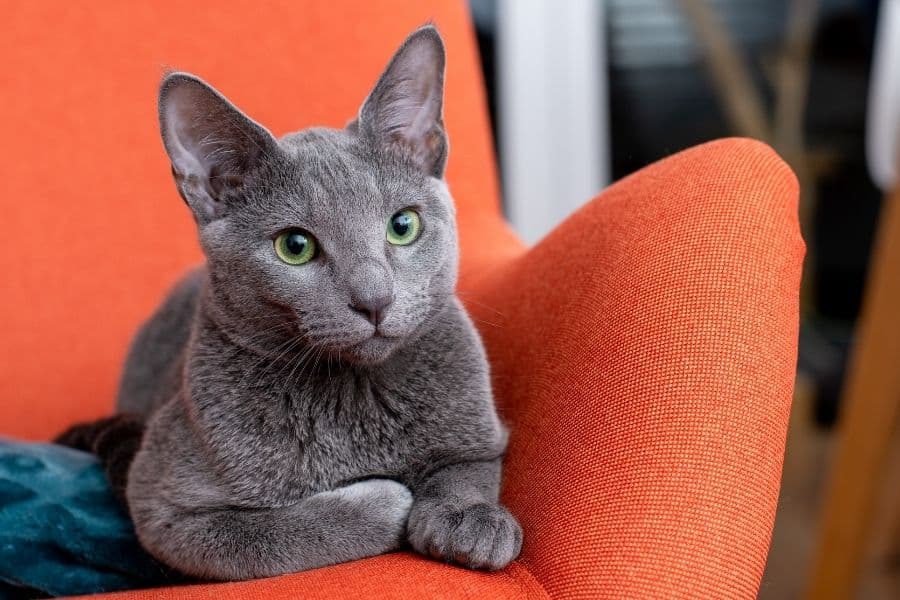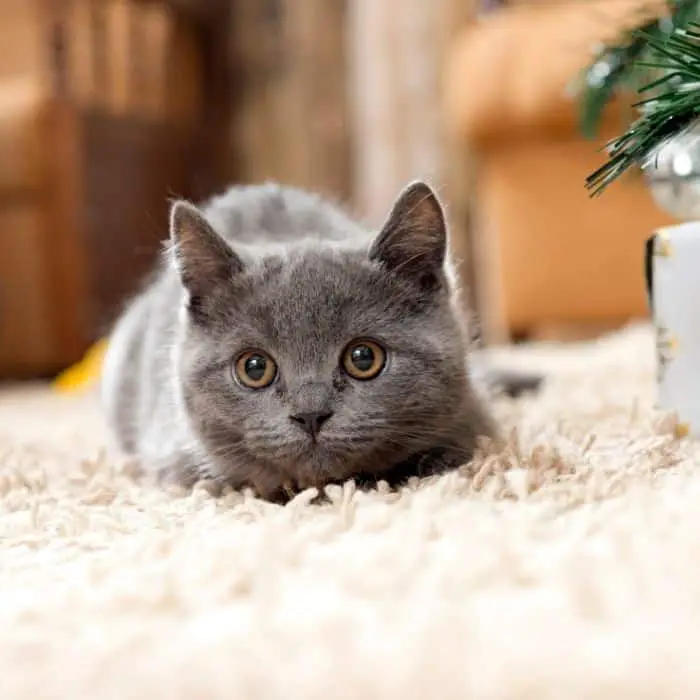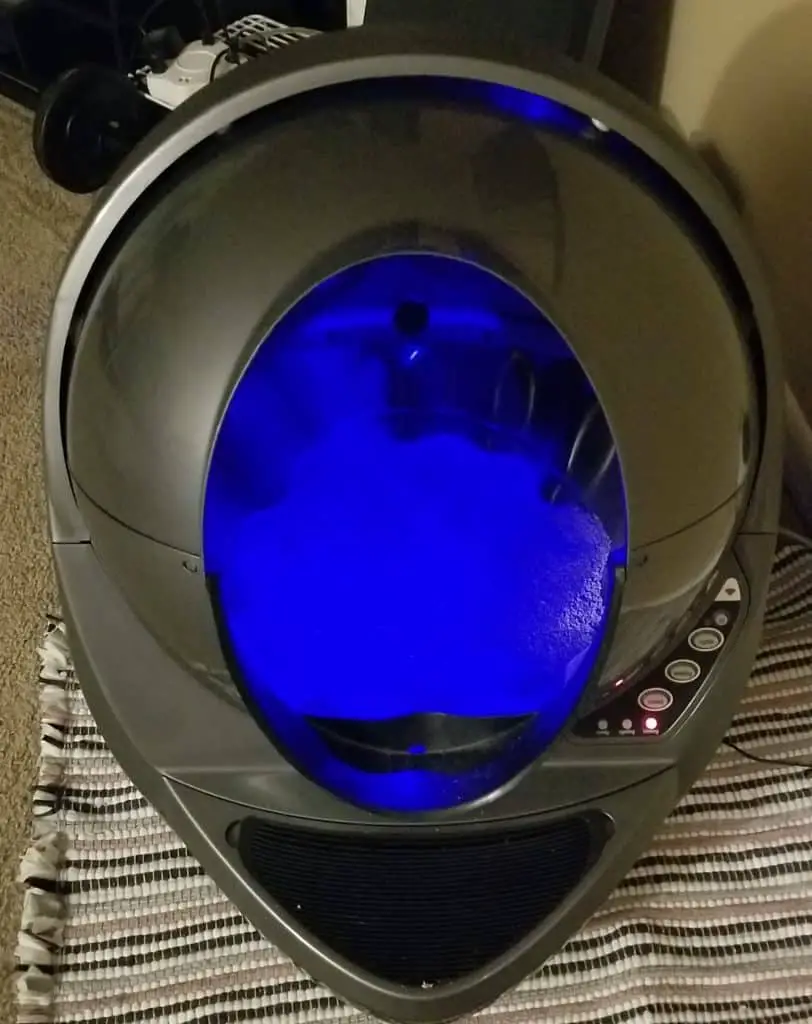More Meows is an Amazon Associate. As an Amazon Associate we earn from qualifying purchases. We may also earn commissions if you purchase products from other retailers after clicking on a link from our site.
Suffering from allergies when interacting with your beloved animals is not a fun ordeal. Luckily, there is a certain cat breed that is sure to pique your interest and keep your nose from running all the time. The Russian Blue cat is an illustrious cat breed that is known for its hypoallergenic properties. But is it true that they are truly hypoallergenic?
The Russian Blue is nearly hypoallergenic. This cat breed contains lower levels of the secretoglobin protein known as Fel D 1. The protein is responsible for the array of symptoms that accompany a cat allergy, such as sneezing, coughing, fever, and more.
While the lower levels of Fel D 1 play a big role, there is a lot to understand about Russian Blues and their nearly hypoallergenic nature. If you are interested in learning more about what makes this strikingly blue cat breed less allergenic, continue reading!
In this article, I’m going to recommend a cat food from Purina on Amazon (affiliate link) that is supposed to reduce allergens in a cat: Click Here To View This Potentially Allergen Reducing Cat Food On Amazon.
Pro-Tip: If you are thinking of buying a cat or are a cat owner already, then you should be aware that taking care of the litter box can be a real chore. In this age of smart products, an automatic litter box has been created that actually makes life easier with taking care of the litter box. If you want to make your life much easier with a litter box that means you’ll never have to scoop litter again, check out the best automatic litter box on the market (in my opinion) on Amazon.

What Makes Russian Blue Cats Hypoallergenic?
No cat is fully hypoallergenic, but Russian Blue cats are nearly hypoallergenic because their saliva has lower levels of the protein Fel D 1 (an allergen) than other cats. Of course, this does not mean that all handlers will be unaffected. Rather, it means that a reaction to the allergen has a much lower likelihood.
The coat of the Russian Blue is responsible for some of its nearly hypoallergenic properties. Below is a list containing the reasoning for this otherwise strange phenomenon.
- A Double-Layered Coat: Since the coat of the Russian Blue is double-layered, the protein has more difficulty spreading throughout the denseness of the fur.
- Less Dander: The Russian Blue naturally produces less dander, therefore, less opportunity for Fel D 1.
- Reduction of shedding: In addition to less dander, the Russian Blue does not shed often.
- Presence of Fel D 1: In combination with the properties listed above, the cat’s lack of Fel D 1 in their saliva becomes less present in all areas. This benefit makes it perfect for those that suffer from cat allergies.
These are just some of the reasons a Russian Blue cat is awesome. To learn more about how awesome Russian Blue cats are, check out my article on the Twelve Reasons Russian Blue Cats Are The Best: Click Here.
Although the Russian Blue naturally comes this way, taking additional steps to take care of your cat will help it to stay nearly hypoallergenic.
Grooming a Russian Blue Cat
Cats of just about all shapes and sizes naturally groom themselves. However, this grooming involves licking. Because Fel D 1 is present in cat saliva and cat fur, the natural grooming process actually exposes owners to more of the secretoglobin.
Comparatively, however, you will not need to worry about your Russian Blue’s natural grooming habits unless you are deathly allergic to cats. The saliva of the Russian Blue is tame compared to other cats and will help you curb allergies – if you have them.
Moreover, the grooming patterns of a feline are largely unavoidable behavior, but there are steps that cat owners can take to ensure their Russian Blue retains its nearly hypoallergenic properties.
Brushing Your Russian Blue
Daily or weekly grooming is recommended to reduce the amount of dander naturally produced by your cat. As mentioned above, the Russian Blue does produce less of this than other cat breeds.
However, the cat still produces some, which can result in symptoms for people that are severely allergic to cat allergens. Taking the time to brush your cat when you notice its coat could use it as a way to detangle fur containing the secretoglobin.
In addition, doing this promotes healthiness within the coat itself, and your cat will likely self-clean less. Either way, the prevention of dander in this way is instrumental in helping your Russian Blue to keep its nearly hypoallergenic status.

Washing Equipment
Considering that cat dander is one of the smallest particulates, the presence of the allergen can be everywhere, especially when you brush your cat or your cat self-cleans. To avoid this, you will want to make sure to wash your cat’s equipment.
The equipment you should pay close attention to and clean includes:
- Brushes: Particulates remain trapped in the hairs of brushes, spreading when picked up or used.
- Collars: The collar of a cat can contain a multitude of cat dander and is often forgotten about.
- Toys: Also often forgotten, your cat’s toys come in contact with your cat’s saliva, hair, and dander more than you may think.
- Blankets: If they have one, wash your cat’s blanket before you notice a build-up of dander becoming present.
Most of these instructions are preventative measures to keep the level of Fel D 1 down. The cat itself makes this pretty easy for you, provided you are willing to take a few additional steps.
Low Allergy Cat Food
In the case of you wanting to be sure that your Russian Blue is as allergen-free as possible, changing their diet in an effort to target the biggest culprit in cat allergens is a future option. A cat’s saliva contains most of the bothersome secretoglobin. Therefore, a diet that can disable it at the source works.
This special diet would have to include a mix of nutrients that is sure to provide your cat with a balanced meal, in addition to including an anti-Fel D 1 protein. This protein is known as the IgY antibody and is a future option to further guaranteeing nearly hypoallergenic statuses.
I usually feed my cat a combination of Purina and Fancy Feast cat foods. Purina has a cat food option on Amazon (affiliate link) that helps reduce allergens on a cat: Check Out This Awesome Potential Allergy Reducing Cat Food on Amazon.
IgY Antibody
An IgY antibody is a special immunoglobulin that is present in chickens. Due to a recent study done by researchers, this antibody could be the key to ensuring that your Russian Blue remains nearly hypoallergenic.
As mentioned, the cat is already naturally nearly hypoallergenic – eating a diet containing the IgY antibody would promote that natural status even more. This is being tested by coating cat food with the IgY protein, ensuring that your cat produces slim to none of the secretoglobin.
This is a future plan and is simply in the developing stage with researchers at the moment. Keep your eyes and ears open, though, because this is a lifesaver for people suffering from cat allergies.
Fel D 1 Levels in Russian Blue’s
To further go into detail about the natural nearly hypoallergenic properties within the infamous Russian Blue, understanding Fel D 1 levels in detail will help you to better gauge its nearly hypoallergenic status.
Most cats produce Fel D 1 through:
- Saliva
- Subcutaneous Glands
- Hair
- Urine
The Russian Blue’s level of Fel D 1 has been tested and examined extensively by researchers throughout the years. Comparatively, the Russian Blue’s levels of Fel D 1 are much less than those of other felines.
The levels mean that most owners who have cat allergies rest well. The qualities within these levels establish the cat as nearly hypoallergenic.
Russian Blue cats have a lot of great traits in addition to their nearly hypoallergenic status. These traits play into why pedigree Russian Blue cats can be pricey. To learn more about why Russian Blue cats are so expensive, check out my article: Click Here.
Can I Still Be Affected?
Even though the Russian Blue is nearly hypoallergenic, you can still exhibit symptoms depending on the severity of your susceptibility to cat dander. If your susceptibility is high, or if you are unsure of how much you will be affected, consider getting an allergy shot.
You can also practice keeping your cat off your personal property to avoid the potentiality of the spread of the allergen.
Symptoms of Fel D 1 Exposure
Exposure to your Russian Blue, despite its nearly hypoallergenic properties, can lead to the following symptoms:
- Sneezing
- Coughing
- Runny Nose
- Sore Throat
- Itching
Note that these symptoms are likely to be less severe due to less natural dander being produced by the Russian Blue. If you are looking for a nearly hypoallergenic cat, the Russian Blue is yours for the taking. But if you suffer from severe effects to Fel D 1, the nearly hypoallergenic properties of this cat may not be enough.
You may end up wanting to give your cat a special place to hang out. My cat, Charlotte (a domestic shorthair) loves her cat tree. I recommend this cat condo / cat tree from Amazon (affiliate link): Check Out This Awesome Cat Tree On Amazon!
Conclusion
Now that you have learned about this elegant cat, you can probably put your fears of having serious allergic reactions away. The nearly hypoallergenic qualities of the Russian Blue coupled with the beauty of this cat make it the perfect breed for you.
If you enjoyed this article, please check out a few others:
- Are Cats Popular In Russia? The Best Answers: Click Here.
- 13 Beautiful Cat Breeds Similar To Siamese Cats: Click Here.
- 9 Reasons For Russian Blue Cat Biting (Epic List): Click Here.
Here are some of my favorite cat products
In addition to checking out some other More Meows articles, I hope you’ll check out some of my favorite cat products as well. These are affiliate links, so if you end up using them, I’ll get a commission at no extra cost to you. These are the products I really do find most helpful.
Litter Box: I started out with normal, traditional litter boxes for my cat. Then, I tried this automatic litter box on Amazon (affiliate link), which helped reduce the litter upkeep. Finally, I am now a believer in the Litter-Robot 3 Connect on Amazon (affiliate link). This robotic litter box is not for everyone based on the price tag, but for me the benefits (very little upkeep, works efficiently, clean, mobile app) far outweighed the cost.

Cat Tree: I have purchased a couple of this Amazon Basics Cat Tree on Amazon (affiliate link). My cat spends a lot of time on and around this cat tree, which I position near my sofa. She uses the scratching posts on this cat tree multiple times a day, which means she is not scratching the sofa instead.
Cat Water Fountain: I love this cat water fountain on Amazon (affiliate link). There are three main benefits to having a water fountain like this for your cat. The first benefit is that it keeps water running so that your cat doesn’t need to drink still water. The second benefit is that it filters the water. The third benefit is that it will keep your cat hydrated!
